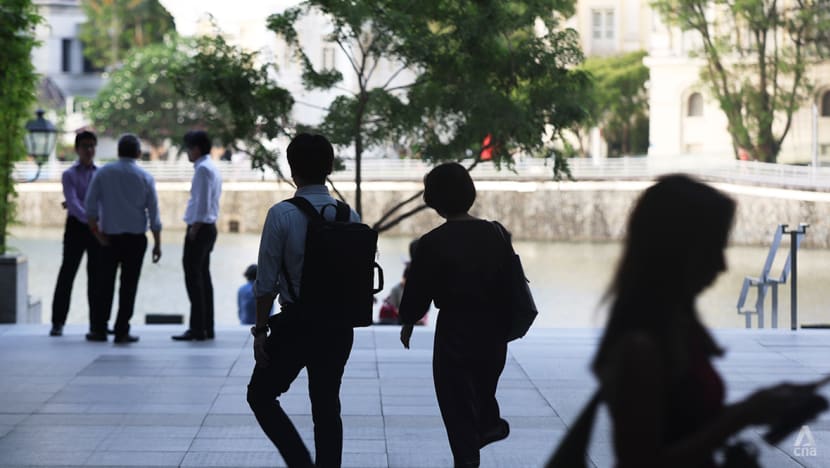Labour force participation rate falls for third year in a row due to ageing population: MOM
In some sectors, the unemployment rate increased due to the rise in retrenchments, the Manpower Ministry said in an advance release of its labour force report.

Office workers in the central business district of Singapore. (Photo: CNA/Raj Nadarajan)

This audio is generated by an AI tool.
SINGAPORE: The proportion of Singapore residents working or actively looking for jobs has continued to drop as the population ages, according to the Ministry of Manpower (MOM) on Thursday (Nov 28).
Out of the working-age population (15 and older), 68.2 per cent were working or looking for work this year, the ministry said in an advance release of its labour force report. That is down from 68.6 per cent last year and 70 per cent in 2022. In 2021, the figure was 70.5 per cent.
This decline in the labour force participation rate is primarily because older people are making up a larger proportion of Singapore residents.
The participation rate has increased across younger age groups, but the overall rate is coming down because among seniors, a smaller percentage are employed or looking for work.
Among those aged 65 to 69, only 50.5 per cent are working or looking for a job, whereas 94.1 per cent of those between 30 and 34 years old are participating in the labour force.
Even then, Singapore's labour force participation rate for seniors ranks high compared with other major cities, the ministry said.
Seniors aged 60 and over make up 18.9 per cent of the work force, while younger residents under 30 years old only make up 14.6 per cent of the labour force.
"The ageing population is something that I think we've been very concerned about," said Mr Ang Boon Heng, director of the manpower research and statistics department.
"It's something that we have been trying to emphasise, MOM is trying to bring back more older workers, trying to increase the employment rates of older workers," he said, adding that Singapore has been "very successful" in that.
The rate has increased over the years. Ten years ago, only 41.2 per cent of 65 to 69 year olds were working or looking for jobs.
Another effect of Singapore's ageing population is that the old-age support ratio has been declining. That means there are fewer residents between the ages of 20 and 64 for every older person.
In 2014, there were six younger residents supporting every senior aged 65 and older. This year, the figure is 3.5, MOM said.
"This ratio is projected to decrease further to 2.7 in 2030," the report added.
"If we include foreign workers, the ratio rises to five. As the workforce ages, it will be necessary to remain open to foreign workers to maintain the support for our ageing population," MOM said in a press release.
Mr Ang said the burden would otherwise fall on the resident workforce in terms of higher taxes.
UNEMPLOYMENT RATE FOR PMETS INCHED UP
Overall, the employment rate of residents aged 15 and over was 66 per cent this year, down from 66.2 per cent in 2023 and the record 67.5 per cent in 2022.
Unemployment rates for professionals, managers, executives and technicians or PMETs increased slightly from 2.4 per cent last year to 2.7 per cent this year, data showed.
MOM said the rate remains low and within historical range. Unemployment in most industries declined or held steady.
But the unemployment rate rose from 3.8 per cent last year to 5 per cent this year in the information and communication sector. In the financial and insurance services sector, unemployment increased from 3 per cent to 3.8 per cent.
MOM said this is "partly due to the rise in retrenchments from business restructuring as global economic headwinds impacted firms in these sectors".
Manufacturing, accommodation and administrative and support services also saw unemployment rates increase.















